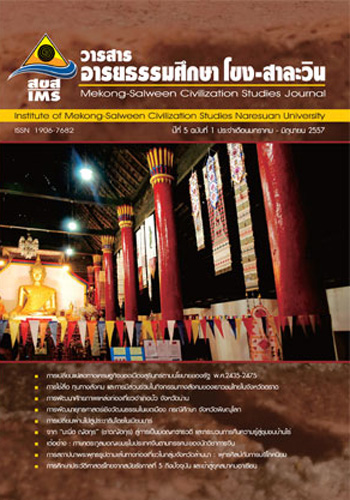ข้อตกลง
1. บทความทุกบทความจะได้รับการพิจารณาจากผู้ทรงคุณวุฒิ (Peer review) ที่ตรงตามสาขาวิชา โดยทุกบทความจะต้องผ่านการพิจารณาจากผู้ทรงคุณวุฒิ อย่างน้อยบทความละ 3 ท่าน
2. บทความ ข้อความ ภาพประกอบ และตารางใด ๆ ที่ตีพิมพ์ในวารสารอารยธรรมศึกษา โขง-สาละวิน เป็นความคิดเห็นส่วนตัวของผู้เขียน กองบรรณาธิการไม่จำเป็นต้องเห็นด้วยเสมอไป และไม่ใช่ความรับผิดชอบของ กองส่งเสริมศิลปวัฒนธรรม มหาวิทยาลัยนเรศวร ถือเป็นความรับผิดชอบของผู้เขียนแต่เพียงผู้เดียว
3. บทความจะต้องไม่เคยตีพิมพ์เผยแพร่ที่ใดมาก่อน และไม่อยู่ระหว่างการพิจารณาของวารสารฉบับอื่น หากตรวจสอบพบว่ามีการตีพิมพ์ซ้ำซ้อน ถือเป็นความรับผิดชอบของผู้เขียนแต่เพียงผู้เดียว
4. บทความที่ส่งถึงกองบรรณาธิการ ขอสงวนสิทธิ์จะไม่ส่งคืน
การสถาปนาพระพุทธรูปตามเส้นทางท่องเที่ยวในกลุ่มจังหวัดล้านนา : พุทธศิลป์กับการบริโภคนิยม
Abstract
หลังทศวรรษ 2510 เป็นต้นมา เส้นทางบกหรือถนนได้เข้ามาแทนที่เส้นทางน้ำในการกำหนดแหล่งที่ตั้งชุมชน รวมถึงกำหนดพื้นที่ศักดิ์สิทธิ์ของชุมชนอีกด้วย “ถนน – ชุมชน – วัด” จึงมีพื้นที่ทับซ้อนกันระหว่างพื้นที่ทางประวัติศาสตร์กับพื้นที่ประวัติศาสตร์ที่เพิ่งสร้างขึ้นเพื่อปฏิบัติการในการรองรับการขยายตัวของชุมชน กระทั่งทำหน้าที่เป็นจุดดึงดูดใหม่ตามนโยบายการท่องเที่ยวตั้งแต่ทศวรรษ 2530 เป็นต้นมา
ในพื้นที่ที่มีประวัติศาสตร์หรือแหล่งวัฒนธรรมนั้น “พระพุทธรูป” ได้ถูกหยิบยกขึ้นมาสร้างสัญลักษณ์เพื่อทำหน้าที่ใหม่ตามเส้นทางหลัก ดังตัวอย่างการสถาปนาพระพุทธรูปศรีสามเมืองบนดอยขุนตาลอันเป็นจุดเชื่อมโยงเส้นทางระหว่างลำปาง ลำพูน และเชียงใหม่ เป็นต้น ทว่ารูปแบบพุทธศิลป์ของพระพุทธรูป ล้วนเป็นงานช่างจากโรงหล่อที่ผลิตซ้ำความงามตามแบบศิลปะอยุธยาหรือศิลปะสุโขทัยอันเป็นกระแสหลัก หาใช่ตัวตนพุทธศิลป์แบบล้านนาแต่อย่างใด ทั้งยังเป็นการระบุนามผู้บริจาคที่มาจากกลุ่มชนชั้นกลางในกรุงเทพฯ หรือชนชั้นนำในภูมิภาคหรือในท้องถิ่นที่กระทำให้กับพื้นที่เส้นทางการท่องเที่ยวนั้นอีกด้วย ตลอดจนเป็นการย้ำความหมายของอุดมการณ์รัฐชาติผ่านพระพุทธรูปในภูมิภาค-ท้องถิ่นอีกประการหนึ่ง
กรณีศึกษาในจังหวัดเชียงราย “ดำริห์ของผู้ว่าราชการจังหวัด” ได้สถาปนา “พระเจ้าล้านตื้อ” ไว้ริมน้ำโขงในพื้นที่สามเหลี่ยมทองคำ(เชียงแสน) ไม่เพียงแต่เป็นการสร้างความทรงจำใหม่ให้กับผู้คนเท่านั้น แต่ยังทำหน้าที่เป็นพรมแดนของรัฐชาติบนชายแดนอีกด้วย ประกอบกับขนาดของพระพุทธรูปได้ขยายให้ใหญ่ขึ้น เพื่อสร้างวัฒนธรรมทางสายตาในการเคารพสักการะ ได้สร้างจุดดึงดูดให้กับผู้คนหรือนักท่องเที่ยว ตัวอย่างเช่น การสร้างพระนอนประดิษฐาน ณ วัดจอมแว่ อ.พาน จ.เชียงราย โดยระบุวัตถุประสงค์อย่างชัดเจนข้อหนึ่งว่า “เพื่อสร้างสัญลักษณ์และเพื่อส่งเสริมการท่องเที่ยว” น่าสนใจว่า พระพุทธรูปหลายองค์ตามเส้นทางท่องเที่ยว ไม่ได้ถูกสถาปนาความศักดิ์สิทธิ์ตามแบบแผนประเพณีเพื่อรองรับการเปลี่ยนผ่านสถานภาพตามคติของชุมชนท้องถิ่น จึงทำให้พระพุทธรูปที่สถาปนากลายเป็นเพียงอนุสาวรีย์ที่มีแต่ความศักดิ์สิทธิ์ชั่วคราว สอดรับกับกรอบการบริโภคที่เป็นตัวกำหนดหรือกระตุ้นอุปทานของการสถาปนาพระพุทธรูปตามเส้นทางท่องเที่ยว ความสัมพันธ์ของพระพุทธรูปจึงสนองต่อการบริโภคสัญลักษณ์ของนักท่องเที่ยวมากกว่า
โปรแกรมการท่องเที่ยวตามนโยบายรัฐ เช่น ไหว้พระ 9 จอม เป็นต้น ร่วมกับนโยบายขององค์กรปกครองส่วนท้องถิ่นที่พยายามสร้างตัวตนผ่านสัญลักษณ์ของพระพุทธรูป ตัวอย่างเช่นการสถาปนาพระแก้วอมรกตไว้ตามเส้นทางอัญเชิญพระแก้วมรกตที่ปรากฏในตำนาน เป็นส่วนหนึ่งที่กระตุ้นการสถาปนาพระพุทธรูปประจำทางระหว่างเมือง หรือพระพุทธรูปขนาดใหญ่ในวัดตามเส้นทางการท่องเที่ยวเพิ่มมากขึ้น กระทั่งบางพื้นที่ก่อเกิดพื้นที่เศรษฐกิจใหม่ โดยเฉพาะอย่างยิ่งการนำเสนอสินค้าและบริการที่ถูกปฏิบัติการสร้างรากทางวัฒนธรรม
Establishing of Buddha image follows the route travels in Lanna’s province group : Buddhist art with consumerism.
2510 decade backs until now , land route - the road- has come in instead of water route in place location community specification include fix holy area of the community as well. “Road, community and Temple(Wat)” then have the area has overlaid to is overlap each other between history area and history area just establish for take action in supporting growth of the community until perform the dot attracts new follow tourism policy since , 2530 decades until now.
In the area that have the history or cultural landscape, “Buddha image” get touch single out upward build the symbol for perform new follow pillar route, for example that “Buddha tree city”on kun Tan hill - the main route between Lampang , Lampoon , and Chiangmai province. but Buddha art styles entirely technician work from a foundry are produce repeated the beauty as Ayutthaya arts or Sukothai arts as pillar trend anyhow in Lanna art. Especially, both of still noun donator source specification from middle-classed in Bangkok or the high society in provincial or in the locality that do to give with route tourism that area as well, including be meaning repetition of state nation ideology changes the image of Buddha in provincial and the locality is on the other hand.
The case study in the Chiang Rai , a governor of a province get establish “Pra Chao Lan Thou” (million gold) placed side the Mekong in triangular gold area(Chiang saen) not only be building new memory give with the people but also still perform the boundary line of nation state on the borderland as well. Assemble with the size has of the image of Buddha enlarges bigly go up for build way sight culture in the salutation worships that build the attracts point to give with the people or tourist, for example building reclining Buddha places at Choum Wae, Phan district, by specify the objective one that , “for build the symbol and for encourage the tourism”. Interesting that many image of Buddhas follow the routes travel are no touch establish the magical power according to regulations the tradition for supports the change of status follows the moral of locality community that to become just a monument that has only the magical power temporary. This phenomena with consuming frame that is formed fix or encourage the imagination of establishing image of Buddha follows the route travels and the relation in the image of Buddha then responds to build consuming symbol of a tourist.
Tourism program follows state policy ,such as pay respect to the 9 temple etc. ,cooperate the policy of local administration that try to build up a fortune the self changes the symbol in the image of Buddha for example establishing Emerald Buddha keeps to follow the route invokes Emerald Buddha that appears in the legend be one part at encourage establishing image of Buddha permanent the way between a city and image of large-sized Buddha in a temple follows tourism route increases , until the somewhere initiates economy new area , particularly the lead presents goods and served that took action build cultural root.







